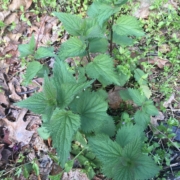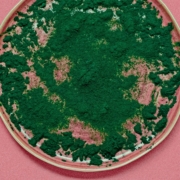Stinging Nettle
 Stinging Nettle (Urtica dioica)
Stinging Nettle (Urtica dioica)
Nettles in Spring.
Nettles full of zing.
The stinging hairs are filled with an acid that can irritate the skin. But don’t let that deter you from getting to know them. Stinging nettle is a generous weed, with much to offer those who dare to treat it with respect.
Parts Used: Leaves, seeds, roots
Actions: Astringent, diuretic, nutritive tonic, alterative, lymphatic
Energetics: Warming, drying
Uses: The leaves are the most common parts of the plant used although the flowers, seeds and roots are used as well. Nettle leaf is highly nutritious. It is our most proteinaceous plant in North America, and is one of the most nutrient dense plants in the world! Nettles contains high amounts of amino acids, chlorophyll, calcium, magnesium, iron, and other minerals. A strong tea, called a nourishing infusion (see recipe below), is recommended as a daily tonic to nourish and strengthen the blood. Nettle tea also makes a great herbal hair rinse that promotes new growth and vibrancy.
Think of nettles as a free and abundant superfood. Cooked nettle leaves may be used in the same way you would use spinach. Cooking or drying nettle removes the sting. Add Nettle to your stir fry, soup or quiche. It also makes a yummy pesto (try mixing it with other spring greens like garlic mustard, chickweed, and dandelion greens).
Nettle has a strong affinity to the urinary system. It is a lymphatic and a diuretic. Used daily, Nettle leaf will increase kidney function and aide in the elimination of toxins from the body. This is useful for conditions such as chronic urinary tract infections, water retention, gout and kidney stones. Nettle seeds of are a trophorestorative for the kidneys, while the root has more of an affinity for the prostate.
Its ability to flush acid wastes from the body can also benefit skin conditions such as eczema, psoriasis and rashes. Nettles are also known to alleviate symptoms of seasonal allergies. For allergies, fresh plant tincture or freeze-dried nettle capsules are best, because these preparations preserve the formic acid which has an antihistamine effect. Most herbalists recommend to start taking nettles 4-6 weeks before allergy season starts. For some this is Springtime tree pollen, for some it is the grass pollen of Summer, and for others the leaf mold of Fall is what makes them sneeze.
Whether you suffer from Springtime allergies or not, Spring is an ideal time to use nettles as Spring is traditionally a time for cleansing. Not the extreme juice fasts and master cleanses that are popular today, but a more natural form of cleansing that uses seasonally-available plants to gently enhance the body’s innate mechanisms of detoxification by supporting the liver, kidneys, and digestive organs.
Because Nettle is so nourishing many people find it energizing. By improving energy levels throughout the day, most people will also find that regular use of Nettles helps them to sleep better as well. But they are drying and some people find them too warming. To offset its drying effects, try mixing it with some moistening plants such as violet. And it’s not advised to use nettle regularly if you are taking prescription diuretics as this can cause too much fluid loss.
Harvesting Nettle Leaf
When approached with attention and respect, nettle can be harvested without stinging. It only stings when it is carelessly brushed or bumped. You can always wear gloves to be extra safe. I like to crop the top 6″ of the plant because this encourages the plant to grow thicker and fuller. Make sure to snip the plant’s stem right above a leaf node. Then you can take your basket of nettle tips inside and pluck the leaves from the stem and spread them on a screen to dry or store the fresh leaves in the fridge to use in cooking.
It’s important to note that you should only harvest nettle leaves in the Spring before the plant goes to flower. Once it flowers it can be too irritating to the kidneys. You also want to be sure that you are harvesting nettle from healthy soil, not on the roadside or a drainage ditch or a field sprayed with chemicals.
If you do get stung, try using fresh plantain leaf, curly dock leaf, or violet leaf as a spit poultice. Chances are you will be able to find one of these growing nearby. If you can’t, just sit with the sensation and know that it is bringing blood flow to the area and that the pain will subside soon. You might find it interesting to know that flogging oneself with nettles was a traditional treatment for rheumatism. The sting brings blood flow to the joints and can help with cold types of arthritis (pain is worse in cold weather and improves with warmth and movement).
How to Make a Nourishing Infusion
Nourishing infusions are essentially a strong herbal tea that is steeped for 4-8 hours or more. It takes this long to extract the minerals from a plant, so this method is used for mineral-rich plants like nettles, alfalfa, oatstraw, raspberry leaf, red clover blossoms, etc.
I like to make mine before going to bed. That way it can steep overnight and is ready to strain in the morning.
To make 1 quart of nourishing infusion, you will need
- 1/2 cup of (dried) plant matter
- 1 quart-sized mason jar
- 1 quart of boiling water
Simply add the herb material to the jar, fill the jar with boiling water and screw on the cap.
In the morning (or after it has steeped for at least 4 hours), strain the tea through a sieve into a clean jar or some other glass vessel. Drink the 2-4 cups throughout the day. You can warm it up, drink it cold, add honey or lemon juice, or anything else to your liking.
Other Nettle Recipes
This website is full of fun ways to add nettle into food & drink
*** This article is for educational purposes only. These statements have not been evaluated by the FDA and this information is not intended to prevent, treat or cure any disease ***


